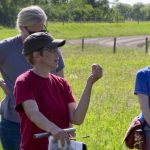
Forages

Now is the time to estimate winter hay needs
Getting a handle on waste can reduce losses and save money

Manitoba to cut Crown forage lease rates
Previous years' forage conditions a factor, province says

Annual forages best in dry years
Trials show better production during drought, says provincial livestock specialist
Teff a promising forage in dry year
Results so far are from small plots in short trials
Nitrate risk comes from variety of sources
It’s not just a drought that increases risk to the herd

Test forages for nitrate prior to haying or grazing
High temperatures combined with adequate moisture can impact metabolism and cause nitrate to build up in plants

Scattered hay market leaves price questions
Growers are struggling to tease out a fair price for hay this year

A marginal pasture takeover
Three years of trials, one drought and two potential methods for inserting legumes in a faltering pasture

VIDEO: What does a healthy pasture look like?
Rangeland biologist answers the question, ‘can cattle be trained to eat spurge?’

Pitching forage as a cash crop
Adding perennial forages to annual crop rotation can pay big dividends, in more than just your bank account


